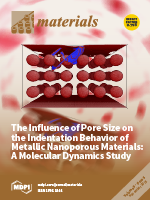1
Department of Inorganic Chemistry, Faculty of Applied Chemistry and Materials Science, University Politehnica of Bucharest, 1–7 Polizu Street, Bucharest 011061, Romania
2
Department of Science and Engineering of Oxide Materials and Nanomaterials, Faculty of Applied Chemistry and Materials Science, University Politehnica of Bucharest, 1–7 Polizu Street, Bucharest 011061, Romania
3
Department of Life and Environmental Physics, “Horia Hulubei” National Institute of Physics and Nuclear Engineering, Magurele 077125, Romania
4
Lasers Department, National Institute for Laser, Plasma and Radiation Physics, Magurele 077125, Romania
5
Microbiology Immunology Department, Faculty of Biology, Research Institute of the University of Bucharest (ICUB), University of Bucharest, 1–3 Portocalelor Lane, Sector 5, Bucharest 77206, Romania
6
Research Center for Microscopic Morphology and Immunology, University of Medicine and Pharmacy of Craiova 2 Petru Rareş Street, Craiova 200349, Romania
7
Research Center for Clinical and Experimental Medicine, University of Medicine and Pharmacy of Craiova 2 Petru Rareş Street, Craiova 200349, Romania
8
Department of Pharmacognosy & Phytotherapy, Faculty of Pharmacy, University of Medicine and Pharmacy of Craiova 2 Petru Rareş Street, Craiova 200349, Romania
Abstract
The aim of this work was to obtain an antimicrobial coating (NanoAg) for polyester-nylon wound dressings (WDs) for reducing the risk of exogenous wound related infections. The as-prepared NanoAg-WDs were characterized by XRD (X-ray Diffraction), SEM (Scanning Electron Microscopy), TEM (Transmission Electron Microscopy),
[...] Read more.
The aim of this work was to obtain an antimicrobial coating (NanoAg) for polyester-nylon wound dressings (WDs) for reducing the risk of exogenous wound related infections. The as-prepared NanoAg-WDs were characterized by XRD (X-ray Diffraction), SEM (Scanning Electron Microscopy), TEM (Transmission Electron Microscopy), SAED (Selected Area Electron Diffraction) and IRM (InfraRed Microscopy). Biological characterization consisted of
in vitro evaluation of the interaction with fibroblast cell cultures and
in vivo biodistribution studies of AgNPs on mice models. Then, specimens of commercial WDs were immersed in a glucose and NaOH solution of silver nanoparticles, followed by the subsequent dropwise addition of AgNO
3 solution. The antimicrobial efficiency of the NanoAg-WDs was assessed by
in vitro qualitative and quantitative analyses on
Staphylococcus aureus and
Pseudomonas aeruginosa strains. The
in vitro and
in vivo studies demonstrated that the tested nanoparticles utilized to coat WDs have a good biocompatibility, allowing the normal development of cultured human cells and revealing a normal biodistribution within a mouse model, without toxic effects. The modified and viable cells count analyses proved that the modified WDs exhibit an improved inhibitory activity of microbial colonization, attachment and biofilm growth. The reported data recommend this type of coatings to obtain modified WDs with antibacterial properties, able to prevent the exogenous microbial contamination of the wound tissue, colonization and further biofilm development.
Full article






